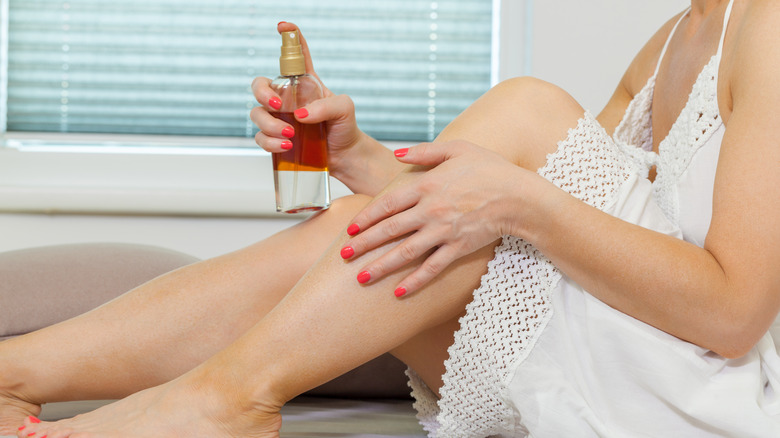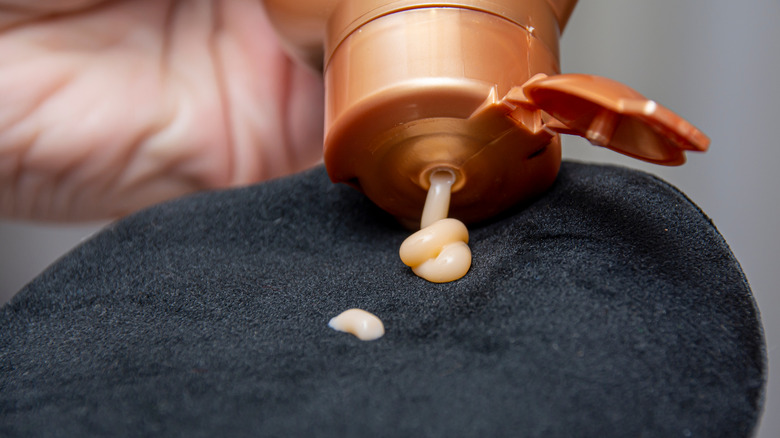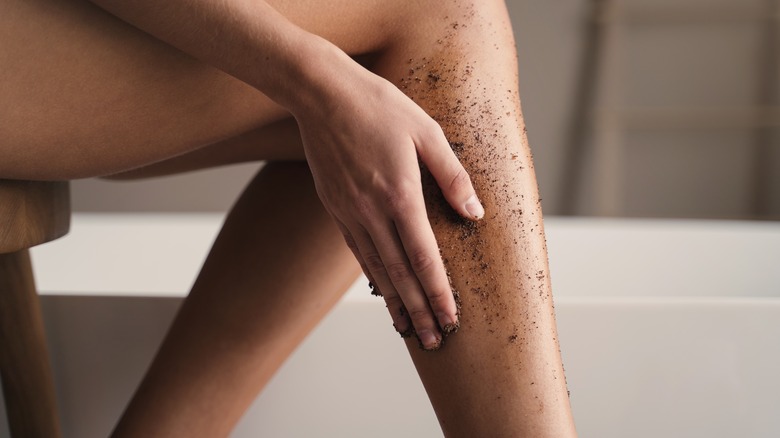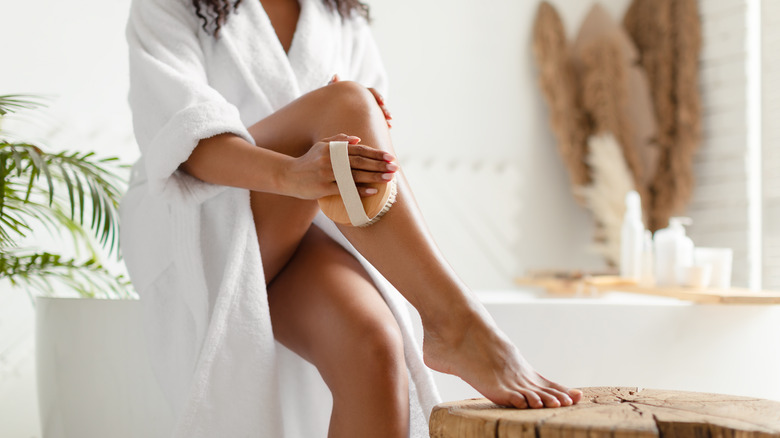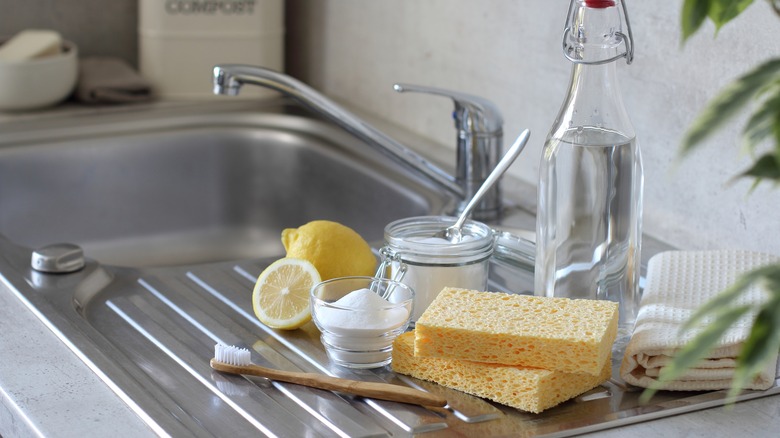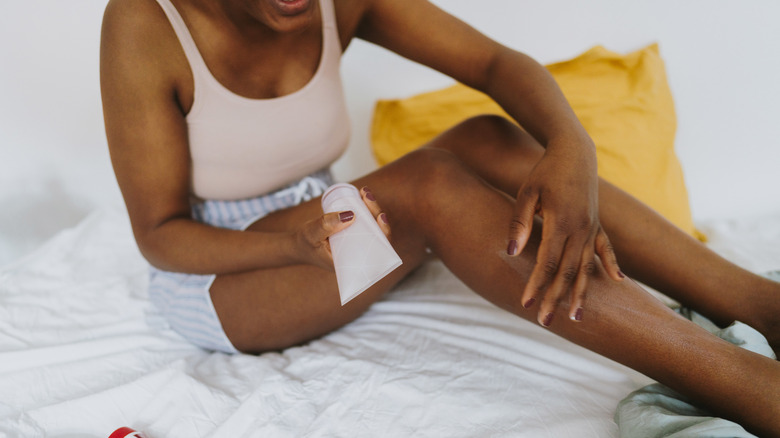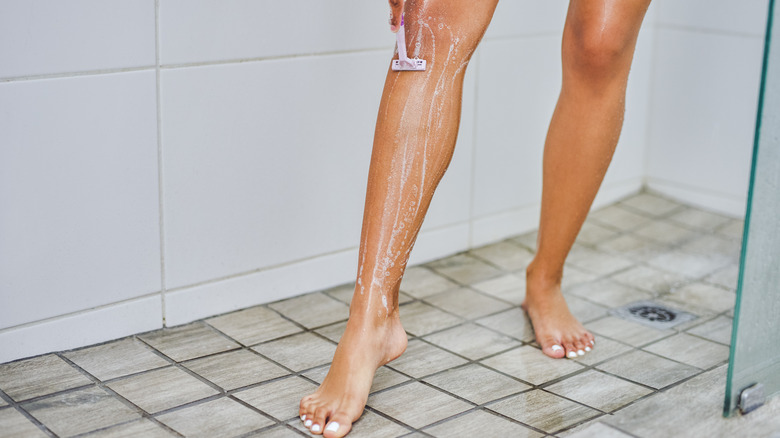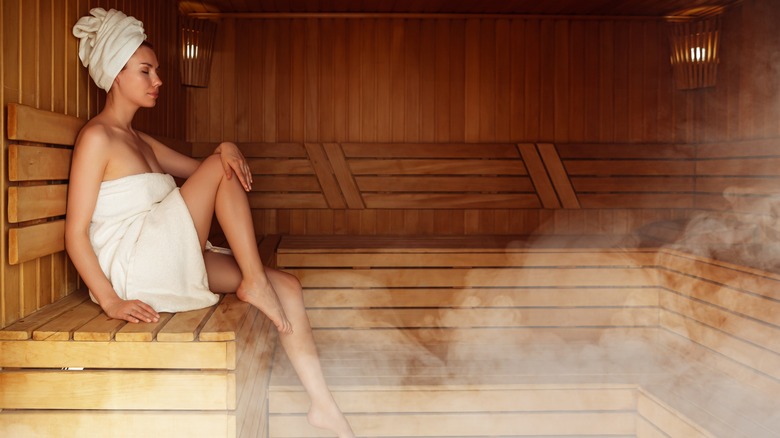What To Do If Your Self-Tanner Just Won't Work On Your Legs
Self-tanner is a great help when there's no sun. However, it can be a little challenging to apply. Plus, when you need a nice, even tan, there's nothing worse than looking down and seeing your legs are still their standard colorless shade. Unfortunately, for self-tan lovers, it's almost a given you will get a bad tan at some point, and legs happen to be one of the common problem areas. The founder of Cocoa Brown, Marissa Carter, tells Byrdie, "It's really common to find that your legs below the knees are often left paler than the rest of your body after washing off your guide tan."
Thankfully, there are various ways you can prevent giving yourself a faulty tan, like keeping track of when you shave or wax and moisturizing. While these tips may appear to sound common, they can go a long way in making sure your leg tan doesn't end up blotchy.
Why your self-tanner won't stick
Before you can fix a tan that didn't work, it's important to know why it fell flat the first time. According to beauty spa Island Glow, the most likely culprit is that you might be doing your pre-self-tan routine incorrectly. If you usually wax or shave your legs, this might be the reason why your self-tan is not sticking to your legs. When you shave or wax, you are opening the pores on your legs, creating an uneven base for your tan, and may even trap the product inside your pores when they close. The website explains that hot showers or baths before tanning can also open pores to the same effect.
Custom Tan explains that there are various other reasons why you may still leave with pale legs after a self-tan. Since your shin area has the thinnest skin, it is more likely that the tan will not properly stick here. This area is tricky for self-tan as it will usually be the first to shed skin, leading to your self-tan rubbing off.
Even if you can't do much about the skin on your shins, there are ways you can ensure you are doing everything you can for an even and spotless glow.
How to fix a bad self-tan
Self-tanning should be a seamless process that leads to sun-kissed skin year-round. Thankfully, there are a few ways you can fix patchy spray tans and ensure you have an even glow. St. Tropez Tanning recommends buffing away excess tan and going over a patchy tan with an exfoliator. All you need to do is scrub the patchy areas until the pigment is no longer there. If you feel it would be easier, simply fill in the lighter areas with another coat of self-tan.
On the other hand, Be Bronze Studio explains that there are plenty of home remedies to get fix a bad self-tan on your legs. Use a combination of baking soda and lemon juice to make a natural paste that will exfoliate patchy areas. This trick comes in handy if you find yourself needing to remove patches. As well as hair removal cream is another product you can easily use to remove a faulty self-tan. Simply smear the hair removal cream over the affected areas and follow the product's instructions.
To prevent your tan from going patchy or rubbing off your legs in the first place, Island Glow recommends showering in cold or lukewarm water and avoiding clothes that are too tight on your skin.
Exfoliate
Whether you are looking to get a more even finish from your next self-tan or are looking to buff off some rough patches, exfoliating is your best bet. "Before applying faux tanner, your skin should be completely clean, dry, and exfoliated to remove any dead, dry skin," says tanning expert and the co-creator of Tournesol Beauty Samantha Magill when speaking to RealSimple on accurately applying self-tanner. If you do not exfoliate off any dead, dry skin before self-tanning, you not only run the risk of your tan fading quicker due to shedding skin cells but also the risk of a patchy finished product. Tanning over skin that is about to be shed will leave some areas fading quicker than others.
If you are looking to prolong your tan and fix up a few spots that seem to be drying faster than others, you can gently exfoliate your body to ensure that the tan is even throughout rather than extra-faded in some areas and extra-dark in others.
Dry brush
Dry brushing has always been around but has recently exploded in popularity due to social media. A dry brush in itself is simply a stiff-bristle bath or shower brush with a longer handle. According to Cleveland Clinic, dry brushing is "a daily body massage with a dry, stiff-bristled brush that's said to help get rid of flaky skin, increase circulation, detoxify, help digestion – and even improve the appearance of cellulite." While many of these claims have yet to be scientifically proven, there are reasons why the process could improve the overall look of your self-tan.
The most obvious reason why dry brushing can improve the appearance of your self-tan is that it removes dead, flaky skin- perhaps one of the most essential beginning steps to self-tanning. Another reason dry brushing is a popular technique to do before self-tanning is because of the lack of water. Hot water can strip your body of essential moisture that is key to an even self-tan.
Use a lemon juice and baking soda mixture
If you are in a sticky situation and have a bad tan that needs a touch-up, simply head to your pantry. Baking soda and lemon juice are the perfect combo for removing a bad tan in a pinch, as per James Read Tan. Sometimes, you forget to exfoliate and moisturize areas of thick, dry skin such as your elbows and wrists, leaving you with a tan much darker in these areas.
If you are in a hurry to remove these dark marks for date night, create a paste out of baking soda and lemon juice. Coconut oil can also work in light of lemon juice. Once the paste texture is created, apply the substance to the targeted area you are looking to lighten. Ensure that the area is completely covered and slathered and keep the paste on the area for 10 minutes before thoroughly removing it from the area. This is much simpler and less harsh on the skin than scrubbing away the self-tan.
Moisturize
Moisturizing your skin is essential to getting and keeping a great tan, as per the experts at Bronze Tan. As previously stated, dry skin is nothing to scoff at when applying a self-tan. While your skin should not be wet or sticky from moisturizer before applying self-tanner, your skin should be supple and hydrated for a long-lasting, even tan. On that note, try using a moisturizer designed for extra hydration that lasts below the surface. Some ingredients to look for when finding a new moisturizer include hyaluronic acid and dimethicone, according to WebMD. Plus, you'll want to look into applying it two or three hours ahead of tanning, shares St. Tropez Tanning.
After all, when your skin cells are moisturized and healthy, they won't shed as quickly, making your tan stay in full force longer. However, people should not use an oil-based moisturizer on their tan, as oils will cause your tan to fade more quickly.
Remove hair before tanning
If you regularly shave your body hair, it is best to do so before using a fake tanner but not too soon before. Hair removal and self-tanning are both very delicate processes that can be irritated by different factors. Shaving after a self-tan will exfoliate some of your tan away, leaving you with patches or a tan that doesn't last. "Plan to do a shave or wax the day before you apply your tan," says celebrity tan artist Jimmy Coco in an interview with Cosmopolitan UK. Though, cult-favorite tanning brand St. Tropez Tanning suggests shaving at least 24 hours before applying a fake tan to avoid the tan from settling into open leg pores.
If you are choosing to wax any hair away rather than shaving, ensure it's also completed at least 24 hours before tanning. After all, wax remaining on the skin can get in the way of the self-tan sticking.
Sit in a sauna
Saunas are mainly used for relaxation and pain relief, but their benefits can go beyond these health effects, explains Healthline. Oftentimes, we hear of people sitting in the sauna at their gym after a hard workout or at the spa after a massage, so why should you sit in a sauna before applying self-tanner? While sitting in a sauna after self-tanning is frowned upon, sitting in a sauna beforehand is often recommended, as per Sauna Helper, as it can help get the skin and body ready to tan.
Sweating does not just cause water loss in the body but also loss of oil and dead skin through the pores, according to Dermatology Consultants of Frisco. Therefore, if you sit and sweat in a hot sauna after applying a self-tanner, it is likely to become streaky and fade much faster. While getting sweaty isn't everyone's favorite past-time, it can be an easy way to prepare for a perfect tan with other benefits, such as making you more alert and less tense.

